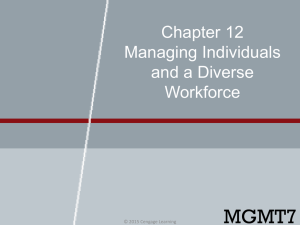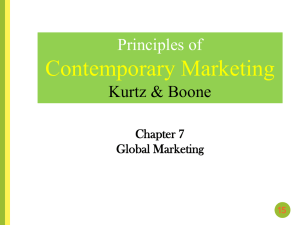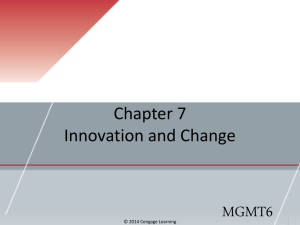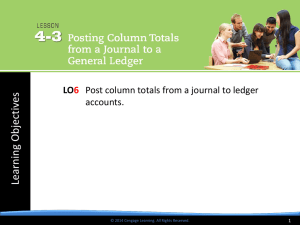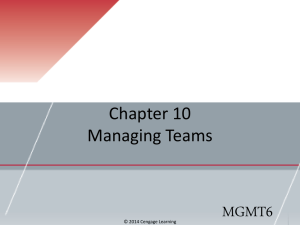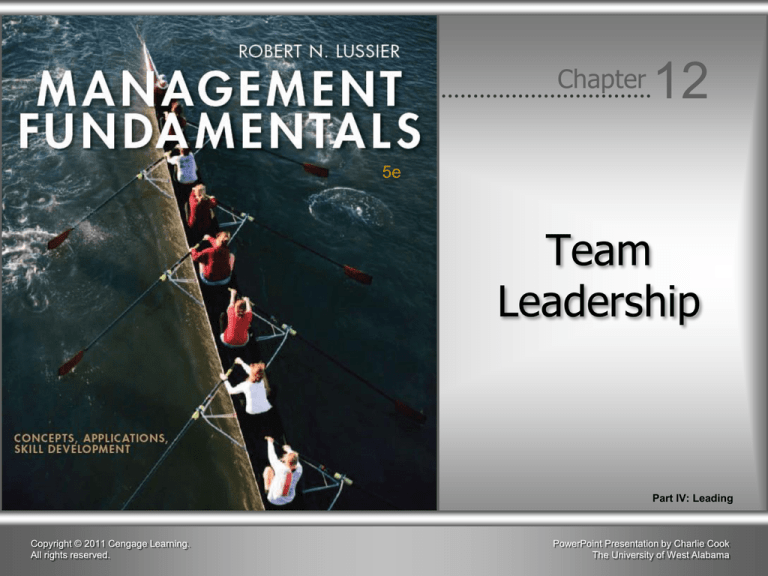
Chapter
12
5e
Team
Leadership
Part IV: Leading
Copyright © 2011 Cengage Learning.
All rights reserved.
PowerPoint Presentation by Charlie Cook
The University of West Alabama
Learning Outcomes
After studying this chapter, you should be able to:
1.
Describe the major differences between groups and teams.
2.
Explain the group performance model.
3.
List and explain the three dimensions of group types.
4.
Define the three major roles played in groups.
5.
State the differences between rules and norms.
6.
Describe cohesiveness, and explain why it is important to teams.
7.
List the four major stages of group development, and describe
the appropriate leadership style usually associated with each.
8.
Explain the difference between a group manager and a team
leader
Copyright © 2011 Cengage Learning. All rights reserved.
12–2
Learning Outcomes (cont’d)
After studying this chapter, you should be able to:
9.
Discuss the three parts of meetings.
10. Define the key terms listed at the end of the chapter.
Copyright © 2011 Cengage Learning. All rights reserved.
12–3
IDEAS ON MANAGEMENT
at W.L. Gore & Associates
1. How does W. L. Gore & Associates benefit from the use of
groups and teams?
2. How does W. L. Gore’s group structure facilitate teamwork?
3. How is group process managed at W. L. Gore?
4. What programs are in place at W. L. Gore to foster group
development?
5. How does W. L. Gore ensure productive meetings?
Copyright © 2011 Cengage Learning. All rights reserved.
12–4
Groups and Teams and Performance
• Group
Two or more members with a clear leader who
perform independent jobs with individual
accountability, evaluation, and rewards.
• Team
A small number of members with shared leadership
who perform interdependent jobs with both individual
and group accountability, evaluation, and rewards.
Copyright © 2011 Cengage Learning. All rights reserved.
12–5
Copyright © 2011 Cengage Learning. All rights reserved.
12–6
Exhibit 12–1 ● Groups versus Teams
Copyright © 2011 Cengage Learning. All rights reserved.
12–7
Join the Discussion
Ethics & Social Responsibility
• Team Players
1. Is it necessary to be a team player to be a
successful employee at JetBlue?
2. Is it ethical and socially responsible of JetBlue to
reject job candidates because they are not team
players?
Copyright © 2011 Cengage Learning. All rights reserved.
12–8
Exhibit 12–2 ●
Group Performance Model
Copyright © 2011 Cengage Learning. All rights reserved.
12–9
Group Structure
Group
Type
Group
Size
Group
Leadership
Copyright © 2011 Cengage Learning. All rights reserved.
Group
Composition
Group
Objectives
3–10
Group Types
• Formal Groups
Recognized (and established) by the organization.
• Informal Groups
Self-formed, not officially recognized by the
organization.
• Functional Groups
Members from a limited organizational area.
• Cross-Functional Groups
Members from different organizational areas and/or
levels.
Copyright © 2011 Cengage Learning. All rights reserved.
12–11
Exhibit 12–3 ● Functional and Cross-Functional Groups
Copyright © 2011 Cengage Learning. All rights reserved.
12–12
Group Types (cont’d)
• Command Groups
Consists of managers and their employees.
• Task Groups
Consists of employees selected to work on a specific objective.
Task Force
Temporary group formed for a specific purpose.
Standing Committee
A permanent group that works on continuing organizational issues.
• Global Virtual Team
Team members are located in different places but work together
as a team using telecommunications technologies.
Copyright © 2011 Cengage Learning. All rights reserved.
12–13
Group Size, Structure, Composition, and Leadership
Teams
versus
Groups
Teams tend to have
few members
Number in
Group
Groups tend to be
larger than teams
Teams are informal and
tend to have participative
leadership
Leadership
and Structure
Groups are more formal and
tend toward autocratic
leadership
Diverse teams outperform
homogeneous groups
Group
Composition
Members should be diverse
and have complementary
skills
Teams develop their
own objectives
Leadership
and
Objectives
Groups have broadlydefined (organizational)
objectives
Copyright © 2011 Cengage Learning. All rights reserved.
12–14
Exhibit 12–4 ● Dimensions of Group Structure
Copyright © 2011 Cengage Learning. All rights reserved.
12–15
Group Process
• Group Process
The patterns of interactions that emerge as members
perform their jobs.
• Group Process Dimensions
Include roles, norms, cohesiveness, status, decision
making, and conflict resolution.
Copyright © 2011 Cengage Learning. All rights reserved.
12–16
Group Process (cont’d)
• Group Roles
Task roles
Members who do and say things that directly aid the
accomplishment of the group’s objectives.
Maintenance roles
Members who do and say things to develop and sustain the
group process.
Self-interest roles
Members who do and say things to hurt the group and help
the themselves.
Copyright © 2011 Cengage Learning. All rights reserved.
12–17
Copyright © 2011 Cengage Learning. All rights reserved.
12–18
Group Process (cont’d)
• Group Norms
The group’s shared expectations of its members’
behavior.
Norms develop spontaneously through the
interactions of group members.
Compliance with norms
is enforced by the group.
Leaders should work toward
maintaining and developing
positive norms.
Copyright © 2011 Cengage Learning. All rights reserved.
12–19
Join the Discussion
Ethics & Social Responsibility
• Norms
1. Should employees be able to “do their own thing”
without group enforcement of norms?
2. Is it ethical and socially responsible for groups to
develop and enforce norms? If yes, what type of
ethical standards should a group have?
Copyright © 2011 Cengage Learning. All rights reserved.
12–20
Group Process (cont’d)
• Group Cohesiveness
The extent to which members stick together.
Factors positively influencing cohesiveness:
Agreement with and commitment to objectives
Small size
Homogeneity among group members
Equal level of member participation
Focus on external competition
A successful group
Copyright © 2011 Cengage Learning. All rights reserved.
12–21
Group Process (cont’d)
• Status within the Group
Status is the perceived ranking of one member
relative to other members in the group.
Based on performance, job title, wage or salary, seniority,
knowledge or expertise, interpersonal skills, etc.
High status members have a strong influence on the
group and its performance.
Copyright © 2011 Cengage Learning. All rights reserved.
12–22
Exhibit 12–5 ● Dimensions of the Group Process
Copyright © 2011 Cengage Learning. All rights reserved.
12–23
Copyright © 2011 Cengage Learning. All rights reserved.
12–24
Stages of Group Development and Styles of Leadership
1. Orientation
Autocratic leadership
2. Dissatisfaction
Consultative leadership
3. Resolution
Participative leadership
4. Production
Empowerment leadership
5. Termination
Copyright © 2011 Cengage Learning. All rights reserved.
12–25
Model 12–1 ● Stages of Group Development and Leadership Styles
Copyright © 2011 Cengage Learning. All rights reserved.
12–26
Developing Groups into Teams
• Training
Train the group in group process skills.
• The Management Functions
Planning: empower members to set objectives,
develop plans, and make decisions.
Organizing and Staffing: have members participate in
selecting, evaluating, and rewarding members.
Leading: develop team leaders who can change
leadership styles as the group develops.
Controlling: have members monitor progress, take
corrective action, and perform quality control.
Copyright © 2011 Cengage Learning. All rights reserved.
12–27
Leadership Skills for Meetings
• Planning Meetings
Objectives
Participants and
Assignments
Agenda
Date, Place and Time
• Conducting Meetings
Three Parts of
Meetings
Identify Objectives
Cover agenda items
Summarize and
review assignments
Leadership
Technology
Copyright © 2011 Cengage Learning. All rights reserved.
12–28
Exhibit 12–6 ●
Meeting Plan
Copyright © 2011 Cengage Learning. All rights reserved.
12–29
Leadership Skills for Meetings (cont’d)
• Handling Problem Members
Silent Type
Talker
Wanderer
Bored Member
Arguer
Copyright © 2011 Cengage Learning. All rights reserved.
12–30
Copyright © 2011 Cengage Learning. All rights reserved.
12–31
KEY TERMS
•
•
•
•
•
•
•
•
command groups
global virtual teams
group
group cohesiveness
group composition
group performance model
group process
group process
dimensions
• group roles
Copyright © 2011 Cengage Learning. All rights reserved.
• group structure
dimensions
• group types
• norms
• stages of group
development
• status
• task groups
• team
• team leaders
12–32



